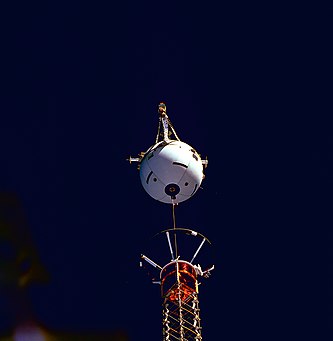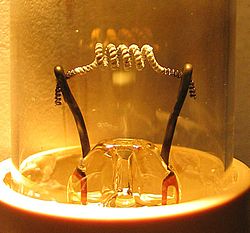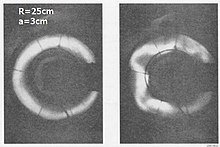Electrodynamic tethers (EDTs) are long conducting wires, such as one deployed from a tether satellite, which can operate on electromagnetic principles as generators, by converting their kinetic energy to electrical energy, or as motors, converting electrical energy to kinetic energy.[1] Electric potential is generated across a conductive tether by its motion through a planet's magnetic field.
A number of missions have demonstrated electrodynamic tethers in space, most notably the TSS-1, TSS-1R, and Plasma Motor Generator (PMG) experiments.
https://en.wikipedia.org/wiki/Electrodynamic_tether
PMG[edit]
A follow-on experiment, the Plasma Motor Generator (PMG), used the SEDS deployer to deploy a 500-m tether to demonstrate electrodynamic tether operation.[21][22]
The PMG was planned to test the ability of a Hollow Cathode Assembly (HCA) to provide a low–impedance bipolar electric current between a spacecraft and the ionosphere. In addition, other expectations were to show that the mission configuration could function as an orbit-boosting motor as well as a generator, by converting orbital energy into electricity. The tether was a 500 m length of insulated 18 gauge copper wire.[21]
The mission was launched on 26 June 1993, as the secondary payload on a Delta II rocket. The total experiment lasted approximately seven hours. In that time, the results demonstrated that current is fully reversible, and therefore was capable of generating power and orbit boosting modes. The hollow cathode was able to provide a low–power way of connecting the current to and from the ambient plasma. This means that the HC demonstrated its electron collection and emission capabilities.[23]
https://en.wikipedia.org/wiki/Space_tether_missions#PMG
A number of space tethers have been deployed in space missions.[1] Tether satellites can be used for various purposes including research into tether propulsion, tidal stabilisation and orbital plasma dynamics.
The missions have met with varying degrees of success; a few have been highly successful.
https://en.wikipedia.org/wiki/Space_tether_missions#PMG
Space tethers are long cables which can be used for propulsion, momentum exchange, stabilization and attitude control, or maintaining the relative positions of the components of a large dispersed satellite/spacecraft sensor system.[1] Depending on the mission objectives and altitude, spaceflight using this form of spacecraft propulsion is theorized to be significantly less expensive than spaceflight using rocket engines.
https://en.wikipedia.org/wiki/Space_tether
Gravity-gradient stabilization (a.k.a. "tidal stabilization") is a method of stabilizing artificial satellites or space tethers in a fixed orientation using only the orbited body's mass distribution and gravitational field. The main advantage over using active stabilization with propellants, gyroscopes or reaction wheels is the low use of power and resources. It can also reduce or prevent the risk of propellant contamination of sensitive components.[1]
The idea is to use the Earth's gravitational field and tidal forces to keep the spacecraft aligned in the desired orientation. The gravity of the Earth decreases according to the inverse-square law, and by extending the long axis perpendicular to the orbit, the "lower" part of the orbiting structure will be more attracted to the Earth. The effect is that the satellite will tend to align its axis of minimum moment of inertia vertically.
The first experimental attempt to use the technique on a human spaceflight was performed on September 13, 1966, on the US Gemini 11 mission, by attaching the Gemini spacecraft to its Agena target vehicle by a 100-foot (30 m) tether. The attempt was a failure, as insufficient gradient was produced to keep the tether taut.[2]
The technique was first successfully used in a near-geosynchronous orbit on the Department of Defense Gravity Experiment (DODGE) satellite in July 1967.[3]
It was first used for low Earth orbit and tested unsuccessfully for geosynchronous orbit in the Applications Technology Satellites ATS-2, ATS-4 and ATS-5 from 1966 until 1969.[citation needed]
The lunar orbiter Explorer 49 launched in 1973 was gravity gradient oriented (Z axis parallel to local vertical).[4]
Long Duration Exposure Facility (LDEF) used this method for 3-axis stabilization; yaw about the vertical axis was stabilized.[5]: 7
An example of gravity-gradient stabilization was attempted during NASA's TSS-1 mission in July 1992. The project failed because of tether deployment problems.[6] In 1996 another mission, TSS-1R, was attempted but failed when the tether broke. Just prior to tether separation, the tension on the tether was about 65 N (14.6 lbs).[7]
https://en.wikipedia.org/wiki/Gravity-gradient_stabilization
https://en.wikipedia.org/wiki/Category:Space_elevator
https://en.wikipedia.org/wiki/Accretion_disk
The hollow cathode effect allows electrical conduction at a lower voltage or with more current in a cold-cathode gas-discharge lamp when the cathode is a conductive tube open at one end than a similar lamp with a flat cathode.[1] The hollow cathode effect was recognized by Friedrich Paschen in 1916.[2]
In a hollow cathode, the electron emitting surface is in the inside of the tube. Several processes contribute to enhanced performance of a hollow cathode:
- The pendulum effect, where an electron oscillates back and forth in the tube, creating secondary electrons along the way
- The photoionization effect, where photons emitted in the tube cause further ionization
- Stepwise ionization[1]
- Sputtering[3][4]
The hollow cathode effect is utilized in the electrodes for neon signs, in hollow-cathode lamps, and more.
https://en.wikipedia.org/wiki/Hollow_cathode_effect
A cold cathode[1] is a cathode that is not electrically heated by a filament.[note 1] A cathode may be considered "cold" if it emits more electrons than can be supplied by thermionic emission alone. It is used in gas-discharge lamps, such as neon lamps, discharge tubes, and some types of vacuum tube. The other type of cathode is a hot cathode, which is heated by electric current passing through a filament. A cold cathode does not necessarily operate at a low temperature: it is often heated to its operating temperature by other methods, such as the current passing from the cathode into the gas.
https://en.wikipedia.org/wiki/Cold_cathode
A plasma globe or plasma lamp (also called plasma ball, dome, sphere, tube or orb, depending on shape) is a clear glass container/ball filled with a mixture of various noble gases with a high-voltage electrode in the center of the container.
When voltage is applied, a plasma is formed within the container. Plasma filaments extend from the inner electrode to the outer glass insulator, giving the appearance of multiple constant beams of colored light (see corona discharge and electric glow discharge). Plasma globes were most popular as novelty items in the 1980s.[1]
The plasma lamp was invented by Nikola Tesla, during his experimentation with high-frequency currents in an evacuated glass tube for the purpose of studying high voltage phenomena.[2] Tesla called his invention an "inert gas discharge tube".[3] The modern plasma lamp design was subsequently developed by James Falk and MIT student Bill Parker.[1]
https://en.wikipedia.org/wiki/Plasma_globe
A Birkeland current is a set of currents that flow along geomagnetic field lines connecting the Earth's magnetosphere to the Earth's high latitude ionosphere. In the Earth's magnetosphere, the currents are driven by the solar wind and interplanetary magnetic field and by bulk motions of plasma through the magnetosphere (convection indirectly driven by the interplanetary environment). The strength of the Birkeland currents changes with activity in the magnetosphere (e.g. during substorms). Small scale variations in the upward current sheets (downward flowing electrons) accelerate magnetospheric electrons which, when they reach the upper atmosphere, create the Auroras Borealis and Australis. In the high latitude ionosphere (or auroral zones), the Birkeland currents close through the region of the auroral electrojet, which flows perpendicular to the local magnetic field in the ionosphere. The Birkeland currents occur in two pairs of field-aligned current sheets. One pair extends from noon through the dusk sector to the midnight sector. The other pair extends from noon through the dawn sector to the midnight sector. The sheet on the high latitude side of the auroral zone is referred to as the Region 1 current sheet and the sheet on the low latitude side is referred to as the Region 2 current sheet.
The currents were predicted in 1908 by Norwegian explorer and physicist Kristian Birkeland, who undertook expeditions north of the Arctic Circle to study the aurora. He rediscovered, using simple magnetic field measurement instruments, that when the aurora appeared the needles of magnetometers changed direction, confirming the findings of Anders Celsius and assistant Olof Hjorter more than a century before. This could only imply that currents were flowing in the atmosphere above. He theorized that somehow the Sun emitted a cathode ray,[2][3] and corpuscles from what is now known as a solar wind entered the Earth's magnetic field and created currents, thereby creating the aurora. This view was scorned by other researchers,[4] but in 1967 a satellite, launched into the auroral region, showed that the currents posited by Birkeland existed. In honour of him and his theory these currents are named Birkeland currents. A good description of the discoveries by Birkeland is given in the book by Jago.[5]
Professor Emeritus of the Alfvén Laboratory in Sweden, Carl-Gunne Fälthammar wrote:[6] "A reason why Birkeland currents are particularly interesting is that, in the plasma forced to carry them, they cause a number of plasma physical processes to occur (waves, instabilities, fine structure formation). These in turn lead to consequences such as acceleration of charged particles, both positive and negative, and element separation (such as preferential ejection of oxygen ions). Both of these classes of phenomena should have a general astrophysical interest far beyond that of understanding the space environment of our own Earth."
https://en.wikipedia.org/wiki/Birkeland_current
An electrojet is an electric current which travels around the E region of the Earth's ionosphere. There are three electrojets: one above the magnetic equator (the equatorial electrojet), and one each near the Northern and Southern Polar Circles (the Auroral Electrojets). Electrojets are Hall currents carried primarily by electrons at altitudes from 100 to 150 km. In this region the electron gyro frequency (Larmor frequency) is much greater than the electron-neutral collision frequency. In contrast, the principal E region ions (O2+ and NO+) have gyrofrequencies much lower than the ion-neutral collision frequency.
Kristian Birkeland was the first to suggest that polar electric currents (or auroral electrojets) are connected to a system of filaments (now called "Birkeland currents") that flow along geomagnetic field lines into and away from the polar region.[1]
https://en.wikipedia.org/wiki/Electrojet
https://en.wikipedia.org/wiki/astrophysical_jet
An electrical grid is an interconnected network for electricity delivery from producers to consumers. Electrical grids vary in size and can cover whole countries or continents. It consists of:[1]
- power stations: often located near energy and away from heavily populated areas
- electrical substations to step voltage up or down
- electric power transmission to carry power long distances
- electric power distribution to individual customers, where voltage is stepped down again to the required service voltage(s).
Although electrical grids are widespread, as of 2016, 1.4 billion people worldwide were not connected to an electricity grid.[2] As electrification increases, the number of people with access to grid electricity is growing. About 840 million people (mostly in Africa) had no access to grid electricity in 2017, down from 1.2 billion in 2010.[3]
Electrical grids can be prone to malicious intrusion or attack; thus, there is a need for electric grid security. Also as electric grids modernize and introduce computer technology, cyber threats start to become a security risk.[4] Particular concerns relate to the more complex computer systems needed to manage grids.[5]
Grids are nearly always synchronous, meaning all distribution areas operate with three phase alternating current (AC) frequencies synchronized (so that voltage swings occur at almost the same time). This allows transmission of AC power throughout the area, connecting a large number of electricity generators and consumers and potentially enabling more efficient electricity markets and redundant generation.
The combined transmission and distribution network is part of electricity delivery, known as the "power grid" in North America, or just "the grid". In the United Kingdom, India, Tanzania, Myanmar, Malaysia and New Zealand, the network is known as the National Grid.
https://en.wikipedia.org/wiki/Electrical_grid
A nuclear reactor, formerly known as an atomic pile, is a device used to initiate and control a fission nuclear chain reaction or nuclear fusion reactions. Nuclear reactors are used at nuclear power plants for electricity generation and in nuclear marine propulsion. Heat from nuclear fission is passed to a working fluid (water or gas), which in turn runs through steam turbines. These either drive a ship's propellers or turn electrical generators' shafts. Nuclear generated steam in principle can be used for industrial process heat or for district heating. Some reactors are used to produce isotopes for medical and industrial use, or for production of weapons-gradeplutonium. As of early 2019, the IAEA reports there are 454 nuclear power reactors and 226 nuclear research reactors in operation around the world.[1][2][3]
https://en.wikipedia.org/wiki/Nuclear_reactor
Tuesday, September 21, 2021
09-21-2021-1438 - waveguide
In radio-frequency engineering and communications engineering, waveguide is a hollow metal pipe used to carry radio waves.[1] This type of waveguide is used as a transmission line mostly at microwave frequencies, for such purposes as connecting microwave transmitters and receivers to their antennas, in equipment such as microwave ovens, radar sets, satellite communications, and microwave radio links.
The electromagnetic waves in a (metal-pipe) waveguide may be imagined as travelling down the guide in a zig-zag path, being repeatedly reflected between opposite walls of the guide. For the particular case of rectangular waveguide, it is possible to base an exact analysis on this view. Propagation in a dielectric waveguide may be viewed in the same way, with the waves confined to the dielectric by total internal reflection at its surface. Some structures, such as non-radiative dielectric waveguides and the Goubau line, use both metal walls and dielectric surfaces to confine the wave.

Collection of standard waveguide components.
https://en.wikipedia.org/wiki/Waveguide_(radio_frequency)





